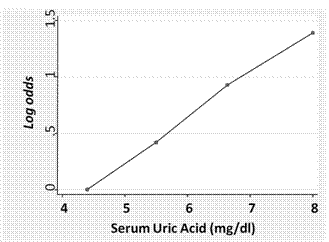Session Information
Session Type: Abstract Submissions (ACR)
Background/Purpose:
the therapeutic goal of the management of gout is to promote crystal dissolution and prevent crystal formation. For this reason national and international guidelines recommend to maintain the serum uric acid (sUA) below the saturation point for monosodium urate (from 5 to 6.38 mg/dl). In this analysis we evaluated the influence of different sUA levels on the risk of acute attack in an observational setting.
Methods:
This is a longitudinal analysis of an ongoing multicentre cohort study including 450 patients with prevalent clinically diagnosed gout from 30 rheumatology centers across Italy (Kick-off of the Italian Network for Gout, KING, promoted by the Italian Society for Rheumatology – SIR; NCT01549210) recruited from June 2011 and January 2012. Participants were centrally selected from clinical registers by random sampling. All patients underwent full clinical evaluation at baseline, including general and disease-specific characteristics. During the first 6 months of follow-up the number of flares, sUA and concurrent treatment were collected.
The relationship between sUA and risk of flare was analyzed using logistic models on complete data, and estimation of the risk of flare is presented as odds ratios (OR) and 95% confidence intervals (CI). The optimal cut-off of sUA was explored by identifying the minimum cut-off associated with a significant increase of risk of flare.
Results:
A total of 178 patients were included in the analyses: 92.7% were male with a mean (SD) age of 64.5 (10.9) years, 22.9% had tophaceous and 18.7% polyarticular disease. Mean (SD) sUA was 6.1 (1.6) mg/dl, of which 26.9% <5mg/dl, 26.4% from 5-6mg/dl, 16.8% from 6-7mg/dl and 29.8 above 7mg/dl. During the follow-up of 6 months 60 patients (33.7%) presented at least one flare with a total of 140 flares.
SUA levels were linearly associated with an increased risk of flare: OR[95%CI] of 1.39 [1.13,1.71] per each mg/dl increase. The adjusted analyses confirmed a similar increase of risk of flare regardless of changes in urate-lowering therapy or prophylactic treatment: OR 1.38 [1.12,1.71]. The minimum cut-off associated with a significant increase of risk of flare was 5.9 mg/dl with an OR of 1.90 [1.01,3.59]. Consistently, using sUA<5mg/dl as reference category, 5-6mg/dl was not associated with a significant increase of risk of flare (OR 1.54 [0.60, 4.15]) while 6-7mg/dl and >7mg/dl were associated with significant ORs: 2.90 [1.03,8.16] and 3.52 [1.43,8.62], respectively.
Conclusion:
The optimal management of gouty patients requires strict control of serum uric acid levels. A virtual absence of risk of flare is associated with levels of uric acid levels below 4mg/dl, but the operative cut-off of 6mg/dl is a robust limit to discriminate patients with increased risk of relapse.
Disclosure:
M. Manara,
None;
C. A. Scirè,
None;
M. A. Cimmino,
None;
M. Govoni,
None;
F. Salaffi,
None;
G. Carrara,
None;
C. Montecucco,
None;
M. Matucci-Cerinic,
None;
G. Minisola,
None;
« Back to 2012 ACR/ARHP Annual Meeting
ACR Meeting Abstracts - https://acrabstracts.org/abstract/serum-uric-acid-control-and-risk-of-flare-according-to-different-cut-offs-in-patients-with-gout-longitudinal-analysis-from-the-king-study-of-the-italian-society-for-rheumatology/

